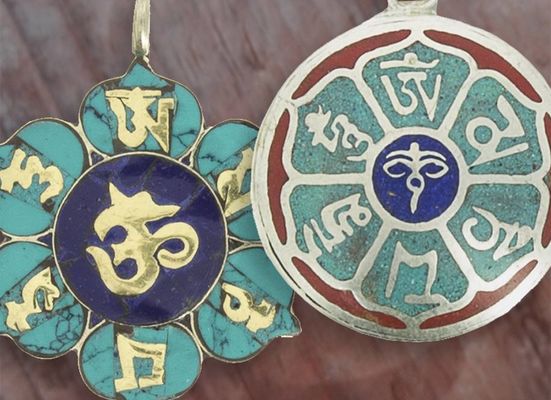
What is “Om Mani Padme Hum”?
In Tibetan Buddhism, it’s believed that reciting Chenrezig’s Mantra, Om Mani Padme Hum, whether out loud or silently to oneself, calls out to Chenrezig, Buddha’s embodiment of compassion. Viewing the written form of the mantra is said to have the same effect—which is why it can be found in places that are easily seen, sometimes even carved in stone.
Spinning the mantra’s written form on a prayer wheel also evokes the same compassion, as a result there are many cylinders with “Om Mani Padme Hum” inscribed inside many times, sometimes even thousands. There are small portable wheels that you can spin with one hand, while there are others so big that spinning them requires several people. According to Tibetan Buddhism masters, all of Buddha’s teachings are in the Om Mani Padme Hum mantra.
Now then, let’s “technically” analyze, step by step, the power of Om Mani Padme Hum:
Every syllable of Om Mani Padme Hum allows us to close the doors of rebirth in one of the six levels that make up the cycle:
- OM: Close the door of rebirth from the side of the devas world.
- MA: Close the door of the asuras.
- NI: Close the door of the humans.
- PAD: Close the door of the animals.
- ME: Close the door of the spiritually hungry (pretas).
- HUM: Close the door of hell.
Every syllable purifies:
- OM: Purifies the body.
- MA: Purifies the speech.
- NI: Purifies the mind.
- PAD: Purifies conflictive emotions.
- ME: Purifies latent conditioning.
- HUM: Purifies knowledge.
Every syllable is a mantra in itself:
- OM: For the bodies of the Buddhas.
- MA: For the Word of the Buddhas.
- NI: For the minds of the Buddhas.
- PAD: For the virtues of the Buddhas.
- ME: For the actions of the Buddhas.
- HUM: For the grace, speech, mind, virtue and actions combined of the Buddhas.
Every syllable corresponds to the Six Paramitas or Transcending Perfections:
- OM: Generosity.
- MA: Ethics.
- NI: Patience.
- PAD: Diligence.
- ME: Concentration.
- HUM: Wisdom.
Every syllable also represents one of the Six Buddhas:
- OM: Ratnasambhava.
- MA: Amaoghasiddi.
- NI: Vajradhara.
- PAD: Vairocana.
- ME: Amitabha.
- HUM: Akshobya.
Each mantra syllable purifies a weakness:
- OM: Pride.
- MA: Envy / Lust for entertainment.
- NI: Personal desire.
- PAD: Stupidity / Prejudice.
- ME: Poverty / Possessiveness.
- HUM: Aggressiveness / Hate.
Lastly, each syllable is related to one of the Six Wisdoms:
- OM: Wisdom of temperament.
- MA: Wisdom of activity.
- NI: Inner Wisdom.
- PAD: Wisdom of Dharma.
- ME: Wisdom of judgement.
- HUM: Mirrored Wisdom.
The Dalai Lama himself, His Holiness the Bodhisattva of Compassion, explains:
“It is very good to recite the mantra OM MANI PADME HUM, but while you are doing it, you should be thinking on its meaning, for the meaning of the six syllables is great and vast.
The first, OM, is composed of three pure letters, A, U, and M. These symbolize the practitioner’s impure body, speech, and mind; they also symbolize the pure exalted body, speech and mind of a Buddha. Can impure body, speech and mind be transformed into pure body, speech and mind, or are they entirely separate?
All Buddhas are cases of beings who were like ourselves and then in dependence on the path became enlightened; Buddhism does not assert that there is anyone who from the beginning is free from faults and possesses all good qualities. The development of pure body, speech, and mind comes from gradually leaving the impure states and their being transformed into the pure. How is this done? The path is indicated by the next four syllables.
MANI, meaning jewel, symbolized the factor of method- the altruistic intention to become enlightened, compassion, and love. Just as a jewel is capable of removing poverty, so the altruistic mind of enlightenment is capable of removing the poverty, or difficulties, of cyclic existence and of solitary peace. Similarly, just as a jewel fulfills the wishes of sentient beings, so the altruistic intention to become enlightened fulfills the wishes of sentient beings.
The two syllables, PADME, meaning lotus, symbolize wisdom. Just as a lotus grows forth from mud but is not sullied by the faults of mud, so wisdom is capable of putting you in a situation of non/contradiction whereas there would be contradiction if you did not have wisdom”


